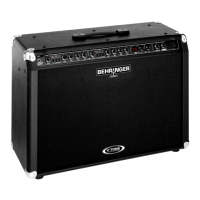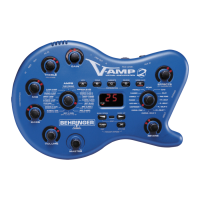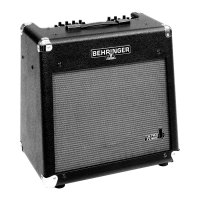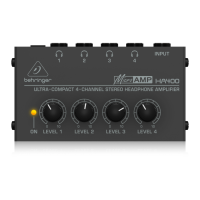9
V-TONE GMX110/GMX210/GMX212/GMX1200H
The multi-effects processor works basically in stereo,
whereby only the TAPE and PHONES outputs are influenced in
the case of the GMX110. Both signals (left and right) are added
up for the speaker and the mono power amp of the GMX110.
However, you can still use stereo effects for recording purposes
by utilizing the TAPE OUT or by playing with a second amp in
stereo. The GMX210 and GMX212 can produce the effects in
stereo because they have two built-in speakers. Stereo
reproduction is also possible with the GMX1200H when the
speakers are connected to it in stereo.
s Turn the PRESET control to dial up an effect preset. While
the preset is loading up, the new program number blinks in
the display. The preset you dialed up is active shortly
thereafter. This new preset is shown in the display.
s Use the FX control to edit the effect. Effect mix is shown in
the display. After 3 seconds, the display shows the preset
number again. The decimal point in the 2-digit display blinks
each time you make a change.
s To store an edit, keep the IN/OUT key pressed for about 2
seconds. This overwrites the previous settings.
s To restore factory presets (reset function), keep IN/OUT
pressed while powering up the V-TONE.
4.1 FXTeffects tracking
FXT is an extremely useful function that lets you assign a
specific effect to each channel of the V-TONE, and then activate
these effects when you switch between the channels.
This way, you can for example assign a DELAY effect to the
MODELING CHANNEL 1, and assign a REVERB/CHORUS
combination effect to the MODELING CHANNEL 2. A single tap on
the CHANNEL key or the footswitch lets you switch between
the channels, and the V-TONE automatically loads up the correct
effect.
When MIDI is active, the above no longer applies. You can
switch between the channels and the effects independently
from one another. How MIDI is activated is described in ch. 4.3.
4.2 The effects
01-02 Spring Reverb: Even on a guitar amp with digital multi-
effects, you should still be able to use a classic spring reverb.
This effect simulates the typical sound of the spring reverb known
from countless guitar amps, and without having the negative
effect of producing rattling noises when the amp vibrates.
03-04 Studio: This effect simulates the characteristics of
midsize rooms. This spatial simulation sounds very natural and
can be used in various setups.
05-06 Chamber: You really get the feeling youre dealing
with some serious walls. This effect is ideal for creating reverb
that doesnt come through as a clear effect, and a dry guitar
sound gets some natural feeling instilled into it.
07-08 Stage: Very nice reverb, great for widening and
freshening up the sound of a clean-sounding guitar.
09-10 Concert: Here, you can choose between a small theater
(preset 9) and a big concert hall (preset 10). Compared to Studio
Reverb, this reverb is livelier and has richer highs.
11-12 Plate: The sound of the classic plates. A true classic, it
gives your guitar sound a nice, pleasant note.
Reverbs 01 to 12 are all available in two versions. The first
one basically uses a short pre-delay (a delay until the reverb tail
starts). The second variation always uses a long pre-delay.
13-14 Gated Reverb: In the air tonight by Phil Collins made
this artificially cut off reverb famous.
15-16 Ambience: The resonance of a room is comprised out
of the so-called early reflections and a reverb tail. This effect
concentrates itself on the simulation of the first 15 early reflections.
Since human hearing uses these reflections to size up a room,
you can create very subtle density without alienating the signal
with long reverb tails. This effect is particularly noticeable when
you use headphones.
17-19 Wah/Delay/Distortion: Filters generally influence the
frequency response of a signal. The Wah effect, in this case
combined with a delay and a distortion effect, lets the middle
frequency response through and suppresses the others more
or less. Jimi Hendrix and Eric Clapton made the Wah effect a
household name. Its an effect that will never be out of fashion.
By using the MIDI controller 15, you can edit the range of the
Wah effect with a MIDI footswitch, among others. This way, the
Wah effect can be used as an analog Wah pedal. You can
modify how prominently the delay effect kicks in.
20 Delay/Reverb: First, an ordinary delay is created. Then,
the signal goes through a reverb with an editable mix ratio.
21-24 Delay (stereo): Delay refers to the delay in the input
signal, with one or more repetitions of the signal (feedback).
With stereo delay, the delay times in the left and the right channel
are not the same length (in order to create a stereo effect). The
delay time in the left channel amounts to two-thirds of the delay
time value in the right channel.
25-29 Delay (long mono): Mono delays offer longer delay
times with a differing number of repetitions (feedback values).
You can use the FX MIX control to determine the effect mix ratio.
30-33 Phaser: Technically speaking, a phaser is a modulation
effect in which multiple phase shifting takes place. Signal
attenuation or amplification of the signal happens through the
modulation of the frequency-dependent phase shift via an LFO
(Low Frequency Oscillator). Depending on the preset, the
phaser can be used either to lightly modulate or to totally alienate
the signal. The sound reminds of a constantly modulating filter.
34-37 Chorus: Lets picture a string quartet in which each
musician plays the exact same sheet music. However, it is only
natural that musicians can never be 100% in tune. This way,
signals that are perpetually out of tune are created, and they are
furthermore temporally superimposed. To recreate this effect,
copies of the original signal are delayed in chorus for 20 - 40 ms,
are tuned out slightly and then modulated through the LFO. This
creates a pleasant-sounding floating effect. Well refrain for
making any recommendations because this effect is used so
often and in so many different ways. Any recommendation about
when to use it would undoubtedly leave out too many other
possible uses.
4. EFFECTS PROCESSOR

